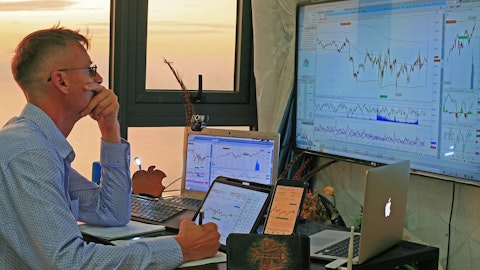Howard Wilson: Yes. So, Chad. I think what I would say is that if you look at our business, our growth primarily comes from expansion. So we tend to have a small land and customers grow with us over time, so lands are important but expansion is always the near-term opportunity for us from a growth perspective. When we look at lands what’s also important for us is the right kind of lands, so this last quarter, we had over 100 enterprise and mid-market lands that we saw was really healthy and strong which lays, a good foundation for us for the future. So the contribution from new — within the first year always remains relatively small new logos. For us, of course, the fact that we do have such a strong installed base that is able to take up new products and add users and can do that with ease and can get to value really quickly, there is a total cost of ownership equation there that doesn’t require a whole lot of effort or so, this is to be able to get up and running, I think puts us in a good place.
Chad Bennett: Got it. And then maybe, any more color, we’ve heard from a lot of calls in this space, just on renewal and expansion conversations with customers and how customers are being a little more cautious on seat expansion and so forth. I’d love your commentary on that, just kind of what you’re hearing, but specifically in the tech sector where you’re seeing some pretty healthy layoffs and whatnot and I know you guys are fairly horizontal from a vertical standpoint, but just any commentary on renewal discussion and seat expansion? Thanks.
Jennifer Tejada: Well. You saw — like I said, I’ve been talking to a lot of customers lately. You saw that we continued to see churn below 5%, starting ARR. So very strong retention of the base renewals, those conversations continued to go well, record number of expansions as customers are looking for new ways to automate more, because they are being asked by their own leadership to do more with less. And so I think all of the automation we’ve built into the platform from detection to orchestration and all the way through to auto remediation is super relevant and timely in this moment. What I would tell you is it’s more that, there are just more approvals in the process like we don’t see deals moving out of the pipeline. We don’t see deals going to competition.
We just see things taking longer, because there’s more diligence associated with how these deals get done. And in long-term, that actually may be good for us, because more and more senior people are going to understand what PagerDuty does and what our value proposition is et cetera, it is little annoying right now, and when you think you’re done and then you find out there is two more approvers, you have never met us before that this has to go through just because they’re trying to control and constrain spend at the top. What this is definitely show me in the conversations that I’ve had with customers, we truly are essential infrastructure. We saw that even in the pandemic when customers, sort of, pump the brakes while they were trying to figure out everything else that they had to figure out at the beginning of the pandemic, when you see those additional approvals come out, we ultimately sort of win the day.
Like I said, it’s just taking a little bit longer. I really like what I’m seeing now in terms of engagement around, some are more advanced use cases, then I think the market probably doesn’t understand yet how important flexible workflows are which we aid recently flexible workflows enable really opening — big opening up of lots of different types of use cases that our customers are looking to leverage PagerDuty for, it’s one of the most requested feature sets that we’ve been asked for over the years and it’s really building catalytic capability and IP into the core platform. So I’m really excited about the discussions that we’re having there as well.
Chad Bennett: Got it. Well thanks, kudos again on the quarter.
Howard Wilson: Thank you, Chad.
Jennifer Tejada: Thank you, Chad.
Operator: Okay. And we’ll hear next from Matt Stotler with William Blair.
Matt Stotler: Thank you for taking the questions. You know, Jen, that’s actually a good segue, because my first question here is going to be on catalytic, right? Obviously, it seems like some pretty compelling, your capabilities that you acquired there. So I would love to get an update kind of the overall integration progress timeline, but also how those capabilities are impacting the conversations you’re having with customers and potentially contributing to the expansion, we’re seeing in the user base at this point?



